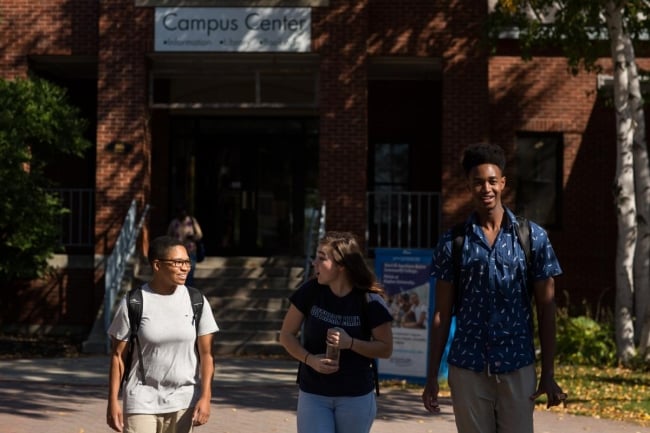You have /5 articles left.
Sign up for a free account or log in.

Maine high school graduates affected by the pandemic can now attend community college for free.
Maine Community College System
Community colleges across the country suffered staggering enrollment losses during the pandemic. But some campus leaders say free college programs might offer the boost institutions need to reverse declines. Multiple states, as well as individual colleges, have started tuition-free programs in the last two years to cover tuition not covered by federal financial aid or other tuition assistance programs.bec
Some colleges that are launching tuition-free programs have set their sights on drawing recent high school graduates, whose rates of enrollment immediately after high school dropped 6.8 percent in 2020 compared to the prior year, according to National Student Clearinghouse Research Center data. Only 2 percent of students who graduated from high school that year but didn't subsequently enroll started college the following year in fall 2021. Other campuses are looking to reengage adult learners over age 25 who may have dropped out to meet mounting work and family responsibilities during the pandemic.
The results of some of these programs, commonly known as promise programs, leave administrators feeling hopeful about the coming fall semester. Although the enrollment numbers are preliminary, Promise programs have led to a swell of applications at some community colleges at a time when these institutions are eager to recoup their losses and fill local worker shortages with new graduates.
'A Substantial Turn Toward the Positive'
"The psychological power of the word 'free' cannot be underestimated," said Janet M. Sortor, vice president and chief academic officer at the Maine Community College System.
She is hopeful about the enrollment outlook for this fall, which they attribute to a new free college program launched statewide earlier this summer. Total applications to the system's seven community colleges are up 11 percent, as of late July, relative to the year before, according to system data. New applicants to the system also increased roughly 13 percent.
The program covers two years of tuition at Maine community colleges for anyone who graduated or is scheduled to graduate high school in 2020, 2021, 2022 or 2023, including current community college students and students who earned a GED.
Like community colleges nationwide, the system experienced significant declines during the pandemic. Student headcount dropped from 11,465 to 9,996 across the system between fall 2019 and fall 2021.
But the system appears to be turning a corner. While enrollment numbers for this upcoming fall are still in flux, they're on an upward trajectory. So far, enrollment of new students increased 15.8 percent compared to last year, and almost 77 percent of those newly registered students are people who qualify for the free college program. Total enrollment across the system increased 4.4 percent, and system leaders expect that figure to continue growing. As of late July, 10,431 students were enrolled for fall 2022.
The increase in new student enrollment in particular gives Sortor hope that the system can recover from pandemic enrollment losses, which she believes will mean greater upward mobility for more Maine residents.
""Postsecondary credentials can make a huge difference in people's lives, in terms of future earnings, job opportunities," she said. " … That's our mission, to help change people's lives and to give them a better future. Getting their attention with that word 'free' … is good for Maine."
Joseph L. Cassidy, president of Southern Maine Community College, doesn't expect the program to bring his institution fully back to pre-pandemic enrollment levels this fall, but he believes it is helping.
He said the nearly 20 percent enrollment drop from fall 2019 to spring 2022 was a gut punch for the college. The healthy labor market filled with well-paying jobs has also made it harder to attract older students, he added.
Still, Cassidy noted that interest in the college by traditional-aged students has notably increased since the program launched.
New applications to the college rose about 17 percent relative to last year, Cassidy said. Total enrollment is only up 4.4 percent so far, but he expects that percentage to grow in the next several weeks.
He and other Maine community college presidents "had dreams of double-digit increases" in enrollment when the free-tuition program was announced, he added. "But in reality, my hope was that we would see a substantial turn toward the positive, that we would actually see notable and measurable growth in enrollment, and that has come to fruition."
Indian River State College, a two-year institution in Florida, has also had success attracting prospective students fresh out of high school with a pilot promise program. The program, announced this spring and funded by the college's private foundation, covers tuition for 2022 graduates of public and public charter high schools in four nearby counties. It requires students to enroll at the college full-time starting in the fall and stay enrolled until they complete their associate degrees.
Elizabeth Gaskin, vice president of student success, at Indian River State, said administrators sought to make the program "as open as possible" to reach not just low-income students but "income constrained" students from middle-income families struggling to afford college.
Gaskin declined to provide enrollment numbers, given that registration is still ongoing, but she said enrollment is up "considerably" compared to last year and she's hopeful the promise program will "stop the bleeding."
About 30 percent of graduates from local public high schools enrolled at Indian River State College before the pandemic, but that figure fell to 23 percent in the fall 2020-21 academic year.
Gaskin said the main objective of the promise program was to return to pre-pandemic rates of enrollment by local public high school students. That goal appears to have been met but she's waiting to celebrate until the semester begins.
"Before I get too, too excited, I want to make sure that they show up for us in that first week of classes," she said.
Gaining and Retaining Students
Morley Winograd, president and CEO of the Campaign for Free College Tuition, said these success stories are in line with national trends. He highlighted a study, published in a 2020 research compendium by the American Educational Research Association, which found that colleges with promise programs had an enrollment increase of 22 percent among first-time, full-time students on average since the programs were implemented, compared to nearby colleges without these programs.
He also pointed to the Michigan Reconnect program as another example of a pandemic-era promise program that prompted a flood of community college enrollments. The program was launched last February and allows adults without college degrees to attend their local community colleges in the state tuition-free. Futures for Frontliners, a similar program targeted at essential workers during the height of the pandemic, also brought a surge of applicants until the program stopped accepting new applications in December 2020.
Michigan Governor Gretchen Whitmer announced last week that, as of late July, Michigan Reconnect alone has accepted at least 100,000 Michigan residents.
Winograd believes the key to a promise program that boosts enrollment is minimal restrictions and a simple message: "Tuition is free. Now please enroll."
"When you give the impression that the aid is not guaranteed, it has almost no effect on enrollment," he added.
Stacey Obi, vice president of strategic innovation at Spartanburg Community College in South Carolina, said to build an effective promise program "you have to understand … who are the students you serve? And what's missing?"
"We know within our community that there is such a large population of students that have some college but no degree, so what we needed to focus on was how to develop a campaign to go after those students and tell them that now is the time, that with this opportunity of free tuition, you can get this done," she said.
Spartanburg used federal COVID-19 relief funds to launch a program last year offering free tuition to prospective students living or working full-time in South Carolina and taking classes that add up to at least six credits. Obi said the college intentionally tried to attract older adults by emphasizing the flexibility of the college's online programming for working learners on billboards and in mailers, among other marketing strategies.
The college enrolled 6,097 students last fall, a 32 percent increase compared to the prior year, and the number of adult learners over age 24 increased 66 percent. Not only did Spartanburg regain its enrollment losses but it far surpassed its pre-pandemic headcount, 4,633 students in fall 2019. As the program enters its second year, enrollment is up 7 percent so far compared to the same time last year, though campus officials emphasized it's too early to tell what the final headcount might be.
A similar opportunity is now available across the state. Governor Henry McMaster also launched a program in 2022 to cover tuition and fees for 15,000 students at career and technical schools in South Carolina.
"When one [institution] does it, now everybody around us wants to be free," Obi said.
She and other campus leaders emphasized, however, that enrollment is only half the battle -- institutions need to be able to ensure students keep coming, stay and graduate.
"While free tuition was an amazing campaign, and it really got ears perked up and students interested … what we did after that … [with] our programming and our supports out there, that's what's driving people to come."
;
Cassidy, of Southern Maine Community College, said the college hired four counselors for first-year students in the free college program to check in with them periodically throughout each semester and "keep a hand on their shoulder, figuratively, to guide them through this first year particularly."
"Because we're bringing different kids to school that may have otherwise not have come, we anticipate there's going to be a lot of those kids who have higher needs in terms of academic support," he said. "We're really working to make sure we don't just get them here, that's a really great starting point, but then we've got to make sure that they're successful."









